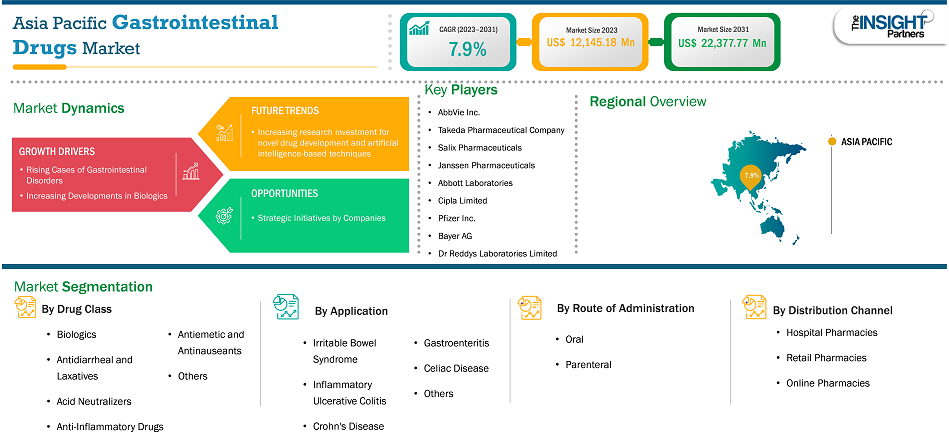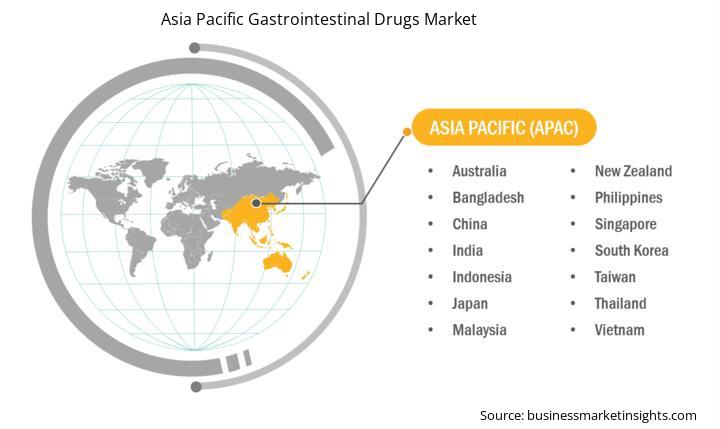Asia Pacific Gastrointestinal Drugs Market Report (2021-2031) by Scope, Segmentation, Dynamics, and Competitive Analysis
No. of Pages: 165 | Report Code: TIPRE00016279 | Category: Life Sciences
No. of Pages: 165 | Report Code: TIPRE00016279 | Category: Life Sciences
The Asia Pacific gastrointestinal drugs market size is expected to reach US$ 22,377.77 million by 2031 from US$ 12,145.18 million in 2023. The market is estimated to record a CAGR of 7.9% from 2023 to 2031.
Executive Summary and Asia Pacific Gastrointestinal Drugs Market Analysis:
Asia Pacific includes countries such as China, Japan, India, Australia, South Korea and Rest of Asia Pacific. The large population of countries such as China and India, the increasing focus of market players on this region, and the introduction of new products or therapies in the country favor the growth of the market. Moreover, the rising prevalence of gastrointestinal diseases, increase in healthcare spending, and availability of advanced technology help to boost the growth of the gastrointestinal drugs market in the region.
Asia Pacific Gastrointestinal Drugs Market Strategic Insights

Asia Pacific Gastrointestinal Drugs Market Segmentation Analysis
Key segments that contributed to the derivation of the gastrointestinal drugs market analysis are drug class, application, route of administration, and distribution channel .
Asia Pacific Gastrointestinal Drugs Market Outlook
Gastrointestinal diseases are becoming prevalent worldwide. Many research institutes are offering funding to accelerate the discovery of new methods for the treatment of gastrointestinal disorders. For instance, Yale School of Medicine receives over US$ 8 million per year in research funding from the National Institute of Diabetes and Digestive and Kidney Diseases (NIDKK). The primary research areas include understanding mechanisms responsible for pancreatic inflammation and pancreatitis genetics and immunobiology of inflammatory bowel disease, as well as complications and treatment of IBD, cirrhosis, viral hepatitis, and liver cancer. In addition, the UNC School of Medicine, which is engaged in the advancement of understanding the impacts of gastrointestinal and liver diseases and developing new treatments, accounted for a gastrointestinal research funding that exceeds US$ 20 million annually. The UNC Center for Functional Gastrointestinal and Motility Disorders has been a top global center for research on constipation, irritable bowel syndrome, and fecal incontinence. The research includes translational studies on the stool microbiome and genetic contributions to IBS, the development and validation of diagnostic criteria, clinical studies of the physiological and psychological mechanisms for symptoms, epidemiological studies, and systems-based research on healthcare delivery.
Gastrointestinal clinical research has evolved over the past decade. The use of Artificial intelligence (AI) is becoming increasingly common in many areas, particularly in the medical field. AI has the potential to revolutionize the design of gastrointestinal clinical research. The integration of AI algorithms enables researchers to extract essential insights from enormous patient data sets, resulting in more accurate and personalized treatments for gastrointestinal conditions. Further, machine learning algorithms help analyze patient data, genetic profiles, and treatment outcomes to find predictive markers for therapy response. By precisely identifying patient subgroups that are most likely to benefit from particular interventions, researchers can optimize treatment strategies and enhance patient outcomes.
AI-powered image analysis has the potential to transform the field of diagnostic imaging in gastrointestinal medicine. Researchers can examine medical images, such as CT scans or endoscopic images, to detect and classify abnormalities with high accuracy by using deep learning algorithms. This technology facilitates the early detection and characterization of gastrointestinal lesions, enabling timely interventions and improving patient prognosis. For example, studies have shown the efficacy of AI algorithms in diagnosing and characterizing colorectal polyps during colonoscopy, reducing the need for unnecessary surgeries. With a US$ 98,700 grant from the Newcastle Permanent Charitable Foundation on research, researchers are able to utilize AI to develop new therapies for IBD and ulcerative colitis. The microbiome and intestinal stem cells are two key components that are significant drivers of IBD but are not targeted by current therapies. identifying therapies from the gut microbiome is a complex undertaking with vast amounts of data, which is why applying AI in such research helps a lot, as it can recognize patterns in enormous amounts of data. AI also enhances the quality of not only the diagnostic process but also of individualized therapeutic strategies.
Thus, increasing research investment for novel drug development and artificial intelligence-based techniques is anticipated to introduce new and innovative treatment solutions for gastrointestinal conditions, which are likely to bring new trends to the gastrointestinal drugs market in the coming years.
Asia Pacific Gastrointestinal Drugs Market Country Insights
Based on country, the Asia Pacific gastrointestinal drugs market comprises China, Japan, India, Australia, South Korea, and the Rest of APAC. China held the largest share in 2023.
China held the largest market share for the gastrointestinal drugs market in Asia Pacific. The growth of the market is primarily attributed to the growing population of China, rising gastrointestinal disease prevalence, surging pharmaceutical sales, increasing developments by the market players, and favorable regulatory policies.
China is among the leading countries that focus on developing healthcare infrastructure as well as different types of medicines. As per a cross-sectional study titled “Prevalence of and factors associated with symptoms consistent with a diagnosis of irritable bowel syndrome among resident physicians in standardized training in China,” published in December 2023, the estimated prevalence of irritable bowel syndrome (IBS) was 7–18% worldwide and 3.2–17.7% in China. The burden of gastrointestinal disease in the country is high, which led the government to implement policies and programs to reduce the prevalence rate. The China Gastrointestinal Health Index (GHI) is a comprehensive evaluation system that helps control the incidence of gastrointestinal diseases. The GHI system can be used to support goals set by the country’s government, such as increasing life expectancy, reducing premature mortality, and enhancing the distribution of medical resources between sub-regions.
The presence of local and international market players in China favors the market growth. For instance, in September 2023, EA Pharma Co., Ltd. and TransThera Sciences, Inc. initiated a strategic research collaboration agreement to develop advanced therapeutics for novel targets in inflammatory diseases of the gastrointestinal system. Under the agreement, both companies jointly dedicated research resources to the discovery and development of potential clinical candidates.
Asia Pacific Gastrointestinal Drugs Market Report Highlights
Report Attribute
Details
Market size in 2023
US$ 12,145.18 Million
Market Size by 2031
US$ 22,377.77 Million
CAGR (2023 - 2031) 7.9%
Historical Data
2021-2022
Forecast period
2024-2031
Segments Covered
By Drug Class
By Application
By Route Of Administration
By Distribution Channel
Regions and Countries Covered
Asia Pacific
Market leaders and key company profiles
Asia Pacific Gastrointestinal Drugs Market Company Profiles
Some of the key players operating in the gastrointestinal drugs market include Sanofi SA, GSK Plc, Johnson & Johnson, Bausch Health Companies Inc, AstraZeneca Plc, Takeda Pharmaceutical Co Ltd, AbbVie Inc, Bayer AG, and Pfizer Inc among others. These players are adopting various strategies such as expansion, product innovation, and mergers and acquisitions to provide innovative products to their consumers and increase their market share.
Asia Pacific Gastrointestinal Drugs Market Research Methodology :
The following methodology has been followed for the collection and analysis of data presented in this report:
The research process begins with comprehensive secondary research, utilizing both internal and external sources to gather qualitative and quantitative data for each market. Commonly referenced secondary research sources include, but are not limited to:
Note: All financial data included in the Company Profiles section has been standardized to USD. For companies reporting in other currencies, figures have been converted to USD using the relevant exchange rates for the corresponding year.
The Insight Partners’ conducts a significant number of primary interviews each year with industry stakeholders and experts to validate its data analysis, and gain valuable insights. These research interviews are designed to:
Primary research is conducted via email interactions and telephone interviews, encompassing various markets, categories, segments, and sub-segments across different regions. Participants typically include:

The Asia Pacific Gastrointestinal Drugs Market is valued at US$ 12,145.18 Million in 2023, it is projected to reach US$ 22,377.77 Million by 2031.
As per our report Asia Pacific Gastrointestinal Drugs Market, the market size is valued at US$ 12,145.18 Million in 2023, projecting it to reach US$ 22,377.77 Million by 2031. This translates to a CAGR of approximately 7.9% during the forecast period.
The Asia Pacific Gastrointestinal Drugs Market report typically cover these key segments-
The historic period, base year, and forecast period can vary slightly depending on the specific market research report. However, for the Asia Pacific Gastrointestinal Drugs Market report:
The Asia Pacific Gastrointestinal Drugs Market is populated by several key players, each contributing to its growth and innovation. Some of the major players include:
The Asia Pacific Gastrointestinal Drugs Market report is valuable for diverse stakeholders, including:
Essentially, anyone involved in or considering involvement in the Asia Pacific Gastrointestinal Drugs Market value chain can benefit from the information contained in a comprehensive market report.